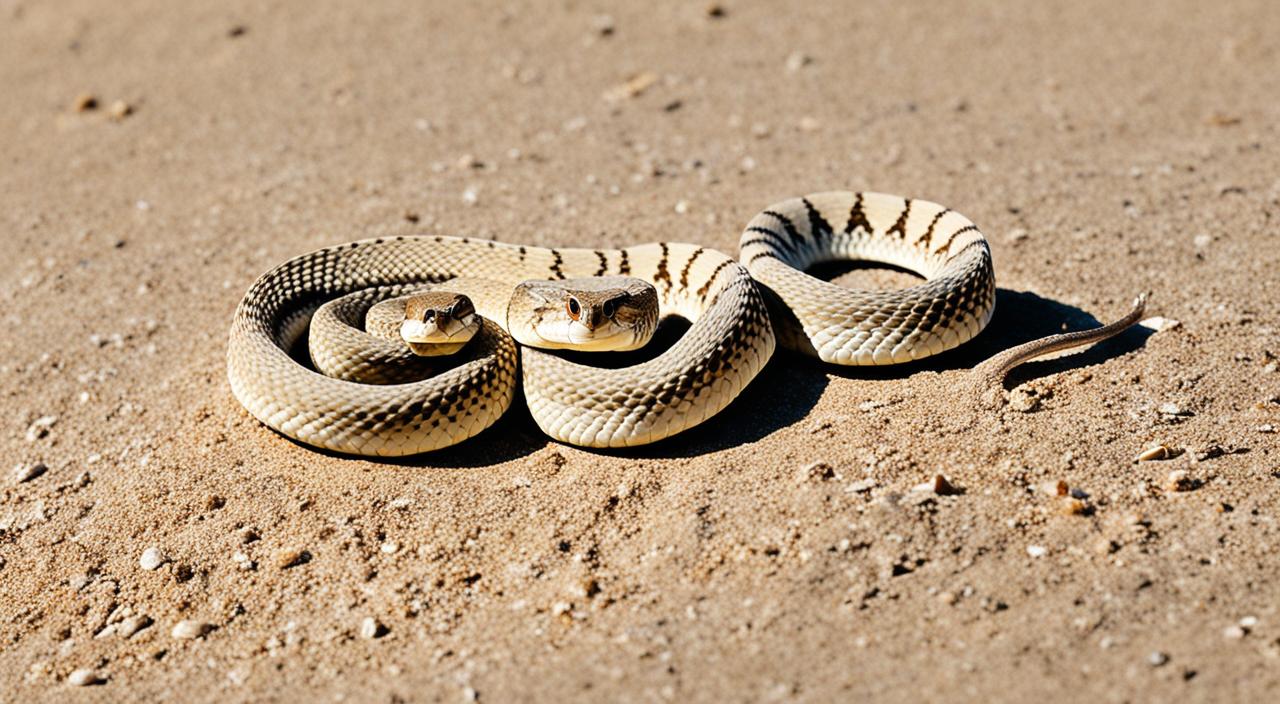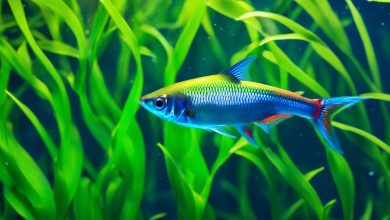Sidewinders, also known as horned rattlesnakes, are found in the southwestern United States and northern Mexico. They are known for their unique way of moving, called sidewinding. This helps them move through the harsh desert environments they live in. Sidewinders can live up to 20 years, making them survivors in the Mojave and Sonoran Deserts.
These snakes are top predators, eating small rodents and lizards. They feed on kangaroo rats, whiptail lizards, and fringe-toed lizards. Their color blends in with their surroundings, and they move in a way that makes them great hunters. They can strike fast and inject venom, though it’s not as strong as some other snakes.
Introduction to the Sidewinder Rattlesnake
Scientific Name and Classification
The sidewinder rattlesnake is known by the scientific name Crotalus cerastes. It is a venomous pitviper in the Crotalinae subfamily. This reptile is ectothermic, meaning it can’t regulate its body temperature on its own. It also has bilateral symmetry, like many other animals.
Physical Characteristics and Appearance
This rattlesnake has unique features like horn-like scales above its eyes and a rattle on its tail. The rattle’s length shows how many times it has shed its skin. Adults average about 50 cm in length, with females being slightly bigger than males.
These snakes show sexual dimorphism, meaning males and females look different. They come in earthy colors like light brown, gray, and cream to hide in the desert. They also have big, venomous fangs that can fold away in their mouths.
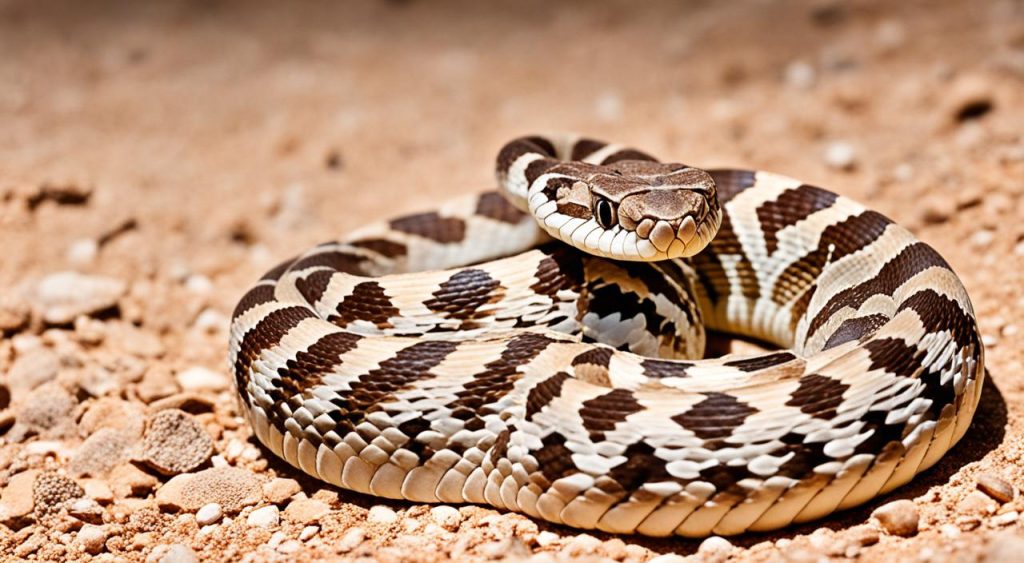
“The Sidewinderrattlesnake typically measures 2 to 3 feet long, categorizing it as a medium-sized snake.”
Sidewinders have special traits for living in the desert. They dig burrows to stay cool and hide from predators. Their sidewinding locomotion lets them move easily in the sand, leaving behind J-shaped tracks.
Habitat and Geographic Range
Desert Environments and Distribution
Sidewinder rattlesnakes live in the southwestern United States and northern Mexico. They call the Mojave Desert and Sonoran Desert home. Their territory stretches from southern California to Arizona. They also live on the eastern coast of Baja California and the northern coast of the Gulf of California.
These snakes love the warm, sandy deserts. They live in washes, dunes, and open terrain. They often hang out near small mammal burrows and places with lots of plants. They can be found from sea level up to 1,830 meters high, with most living around 1,200 meters up.
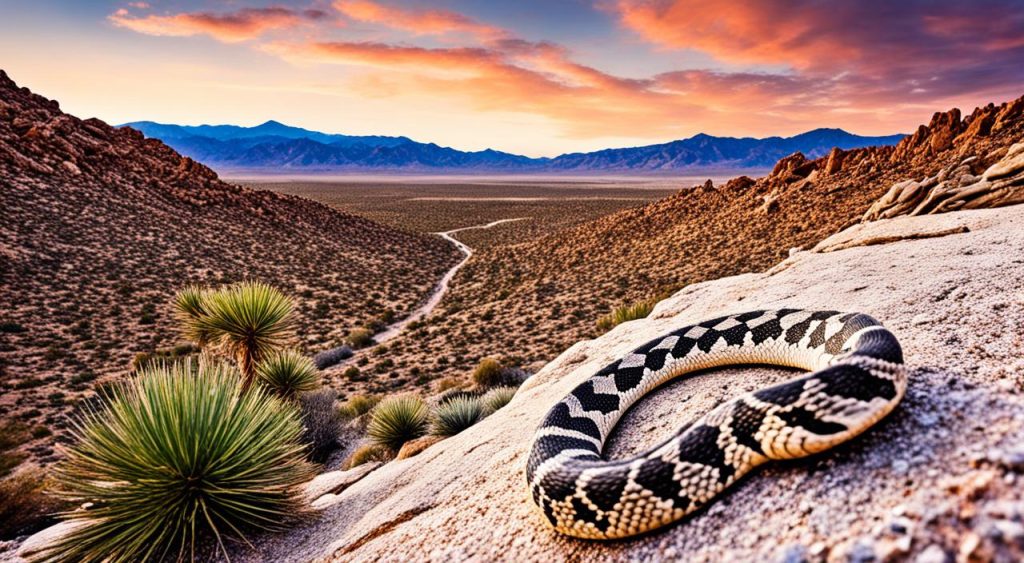
Sidewinders prefer living in the desert, in places like sandy washes, sand dunes, and open areas. They’re great at surviving the hot, dry conditions of the Mojave and Sonoran Deserts. They often hide in the sand or use rodent burrows for shelter and safety.
| Desert Region | Elevation Range | Habitat Preferences |
|---|---|---|
| Mojave Desert | Sea level to 1,830 m | Sandy washes, dunes, open terrain |
| Sonoran Desert | Sea level to 1,200 m | Sandy washes, dunes, open terrain |
| Baja California | Sea level to 1,200 m | Coastal desert areas, sand dunes |
| Gulf of California | Sea level to 1,200 m | Coastal desert areas, sand dunes |
Sidewinder Locomotion and Movement
Sidewinders are known for their special way of moving called sidewinding. This lets them move across the desert sand without getting too hot. It also saves them energy.
This movement, called lateral undulation, starts with the snake’s middle part, not its head. Their belly skin has tiny pits and fewer spikes. This helps them move more efficiently.
They can also move in straight lines and with lateral undulations. But, they mostly use sidewinding. This helps them find food and mates over long distances. Males often go farther than females.
“The research provides insights into convergent evolution, where different species independently evolve similar traits due to adapting to similar environments.”
Studies show that other snakes have spikes on their skin for speed. But sidewinders don’t. They have pits and no spikes, perfect for sidewinding.
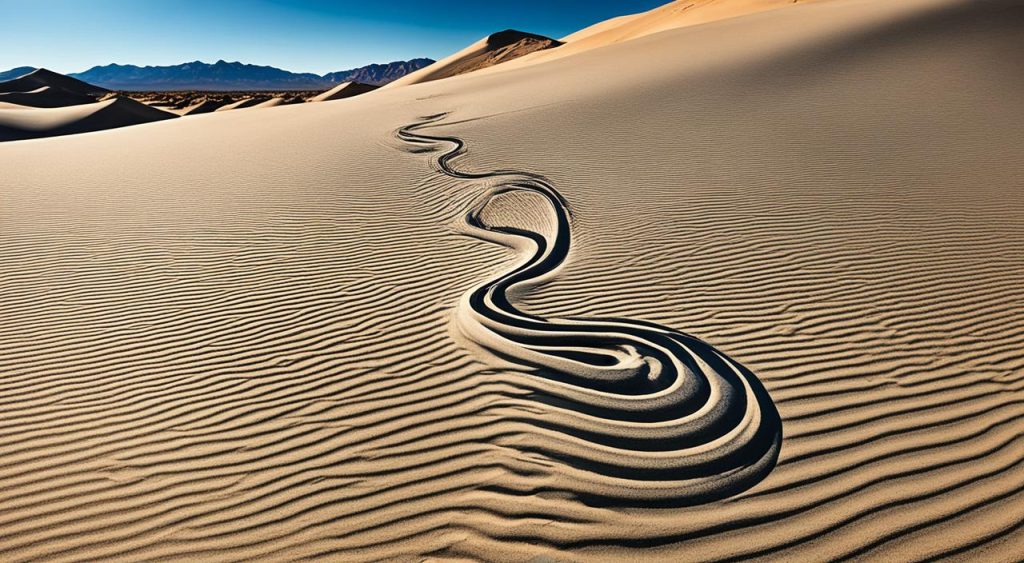
This research shows how sidewinders have adapted to the desert. Their unique way of moving helps them survive in tough conditions.
Diet and Feeding Habits
Sidewinder rattlesnakes, known as Crotalus cerastes, mainly eat small rodents and lizards. They hunt kangaroo rats, whiptail lizards, and fringe-toed lizards. These snakes are active hunters but also use an ambush hunting strategy. They hide in the sand and use their tail to lure prey.
Prey Species and Hunting Behavior
When they find prey, sidewinders strike fast, using their venom to kill and eat it whole. They eat more lizards in early spring and autumn, and more mammals in late spring and summer.
Adult male sidewinders eat more mammals than young males. Female and young sidewinders eat lizards and mammals equally. Their eating habits change with age and size.
| Prey Species | Percentage in Diet |
|---|---|
| Lizards | 60% |
| Rodents | 35% |
| Other Prey (Birds, Snakes) | 5% |
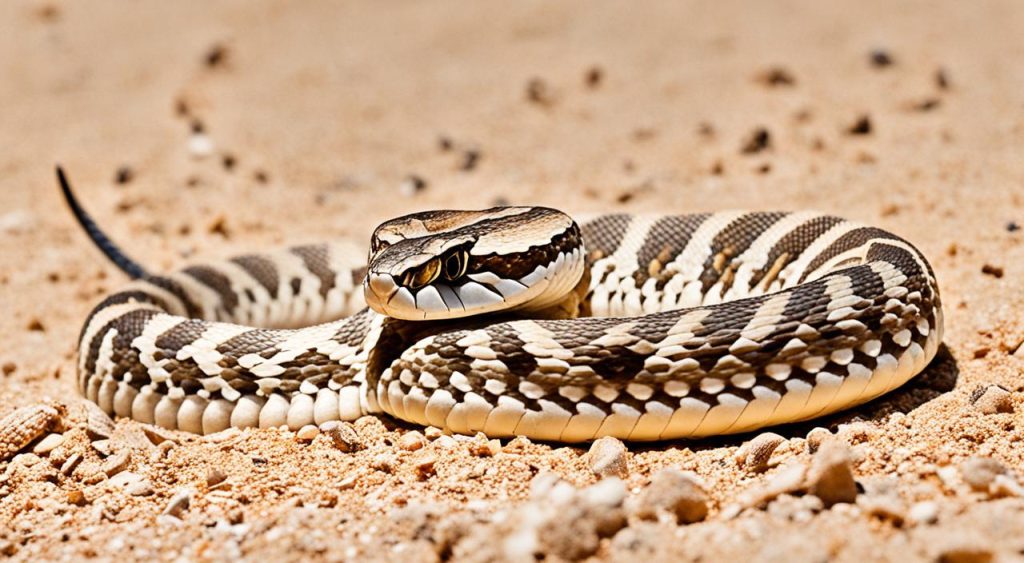
Sidewinders hunt in different ways, like active hunting and ambush predation. They hide in the sand and use their tail to lure prey. This hunting strategy helps them catch prey without using a lot of energy.
Reproduction and Life Cycle
The sidewinder rattlesnake, known as Crotalus cerastes, is a viviparous species. This means they give birth to live young instead of laying eggs. Their reproduction depends on the environment. Males are ready to mate every year, while females need warm conditions to reproduce.
Mating Rituals and Live Birth
In spring or early summer, male sidewinders travel far to find and court females. These rituals help males show dominance and get mating chances. After mating, females carry their young for about 2-3 hours before giving birth to 4 to 11 live babies. These babies are on their own just a few hours after birth, and the mothers leave them soon.
Sidewinders become ready to mate at 4 to 6 years for males and 7 to 13 years for females. In the wild, they live about 5 years for females and up to 13 years for males. In captivity, they can live over 20 years, especially females if well-fed.
“Sidewinders exhibit unique mating behavior, with females potentially mating with several males in a season.”
- Sidewinders are viviparous, giving birth to live young instead of eggs.
- During courtship, males compete to be the top mate.
- Females have litters of 4 to 11 live young, which grow independent quickly.
- Sidewinders become sexually mature at 4 to 6 years for males and 7 to 13 years for females.
- In the wild, they live about 5 years for females and up to 13 years for males. In captivity, they can live over 20 years.
Sidewinder Behavior and Adaptations
Sidewinder rattlesnakes have evolved amazing behaviors and adaptations for the desert. They have complex ways of living in their home range and territory. Males travel more than females, especially when looking for mates.
These snakes are usually alone but come together in dens during winter for hibernation. They are active both in the day and at night. But, they mostly stay in the dark during the hottest months, hiding in burrows to stay cool.
Burrowing and Hibernation
Sidewinders can burrow into the sand to stay cool. This is key in the summer, when they spend most of their time underground. It helps them avoid the extreme heat on the surface.
In winter, they go into a state of hibernation together in dens. This helps them save energy and stay warm in the cold. It’s a way for them to survive in the desert, where food and water are hard to find.
Their unique way of moving helps them avoid the hot ground. This, along with their heat-sensing pits and protective scales, lets them live in the desert’s harsh conditions.
Conservation Status and Threats
The sidewinder rattlesnake (Crotalus cerastes) is listed as Least Concern on the IUCN Red List. This means it has a stable population and is found widely in the southwestern United States and northern Baja California. But, this snake faces threats that need constant conservation work.
Human activities are taking over the sidewinder’s desert home. More than half of the sidewinders found in studies were on roads. Sadly, 14% of them were dead from car crashes.
It’s believed that between 2,383 and 4,000 sidewinders die each year from roadkill in the southwestern United States. Road traffic and development break up their habitat, making it harder for them to live together.
| Habitat Survey | Number of Sidewinders Observed |
|---|---|
| Transect Surveys | 36 out of 519 total |
| Wash Surveys | 176 out of 519 total |
| Road Cruising Surveys | 69 out of 519 total |
Researchers are trying to find ways to keep an eye on sidewinder populations over time. They’re also studying the snakes’ genes to learn more about their diversity and how they connect with each other. This will help make plans to protect their homes and keep the sidewinder alive in the wild.
Fascinating Facts About Sidewinders
Sidewinder rattlesnakes, also known as the “horned rattlesnake,” have amazing adaptations for the desert. They have unique features and abilities that catch the eye of anyone interested in nature.
Unique Features and Abilities
The horn-like scales above their eyes protect the sidewinder from the desert sun. Their rattle grows with each shed, warning predators to stay away.
They are masters of camouflage, blending into the desert sand and rocks. This helps them hide from both prey and predators.
Sidewinders move in a special way called sidewinding. This lets them move across the sandy desert efficiently. It saves energy and keeps them from getting stuck.
They have a lower metabolic rate than other snakes. This means they use less energy, which is important in the desert where food is scarce.
“Sidewinders are truly remarkable creatures, perfectly adapted to the harsh desert environment they call home.”
Sidewinder rattlesnakes are fascinating and awe-inspiring. Their unique features and adaptations make them stand out.
Sidewinder Research at Zoo Atlanta
At Zoo Atlanta, researchers are working with Georgia Tech and Carnegie Mellon University. They study how sidewinder rattlesnakes move through sand. They want to make robots that can move like these snakes in tough terrains.
Experts in physics, engineering, and biology are part of the team. They’re figuring out how sidewinders move. This could lead to robots that can go through hard-to-reach places, helping with search-and-rescue, military tasks, and archaeology.
This project has been going on for six years. It has led to big discoveries, shared in the Proceedings of the National Academy of Sciences. Researchers from Georgia Tech and Zoo Atlanta looked closely at the scales of sidewinders. They used special tools to learn how these scales help them move.
| Research Collaborators | Findings |
|---|---|
| Georgia Tech Carnegie Mellon University University of California Riverside Emory University City University of New York | Absence of microspicules in African sidewinding species Reduced scale protrusions in North American sidewinders Convergent evolution of skin textures in various snake species Implications for the development of snake-inspired robots |
This research got funding from the Georgia Tech Elizabeth Smithgall Watts Fund, the National Science Foundation, and the Army Research Office. Thanks to teamwork, Zoo Atlanta is making big strides in understanding how sidewinders move. This could lead to new advances in robotics and exploring deserts.
Viewing Sidewinders at the Zoo
At Zoo Atlanta, visitors can see sidewinder rattlesnakes in the indoor gallery of the Scaly Slimy Spectacular exhibit. These snakes are usually still, but sometimes they move in their special way. This lets them move fast over sandy desert ground.
Sidewinders are shy and like the night. So, seeing them move is not common. But, the zoo’s team works hard to make learning about these snakes fun and interesting for everyone.
The zoo has interactive exhibits and signs that teach about the sidewinder’s special traits and how they hunt. It also talks about the research on how they move. This helps visitors understand and care more about these snakes and their desert homes.
FAQ
What is a sidewinder and where is it found?
The sidewinder is a type of rattlesnake found in the southwestern U.S. and northern Mexico. It lives in the Mojave and Sonoran Deserts.
How are sidewinders classified and what are their physical characteristics?
Sidewinders are known as Crotalus cerastes and belong to the venomous pitviper group. They have horn-like scales above their eyes, rattle tails, and colors that help them blend into the desert.
What is the habitat and geographic range of sidewinder rattlesnakes?
Sidewinders like warm, sandy places like washes and dunes. They live from southern California to Arizona. They also live in Baja California and the northern Gulf of California.
How do sidewinders move and what are their unique locomotion abilities?
Sidewinders move in a special way called sidewinding. This helps them cross sandy areas easily. They also use other ways to move, but sidewinding is their main way to cover distance.
What do sidewinders typically eat and how do they hunt their prey?
Sidewinders eat mostly small rodents and lizards. They hunt actively or lie in wait for prey. Their venom helps them catch and kill their food.
How do sidewinders reproduce and what is their life cycle?
Sidewinders have live young instead of eggs. Their reproduction depends on the environment. Males are ready to mate every year, and females need warm conditions to have babies.
What are some of the unique behavioral adaptations and features of sidewinder rattlesnakes?
Sidewinders have special behaviors and adaptations for the desert. They have large territories and gather in dens during the cold months. They are active both day and night. Their horn-like scales and rattle help protect them.
What is the conservation status of sidewinder rattlesnakes, and what threats do they face?
Sidewinder rattlesnakes are generally stable, but they face threats. Habitat loss from human activities and being hit by cars are big dangers.
How are sidewinders being studied at Zoo Atlanta, and what are the potential applications of this research?
At Zoo Atlanta, researchers study how sidewinders move to make snake-inspired robots. These robots could help with search-and-rescue, military tasks, and exploring the desert.
Can visitors observe sidewinder rattlesnakes at the zoo, and what are the challenges in seeing their unique behaviors?
At Zoo Atlanta, you can see sidewinder rattlesnakes in the Scaly Slimy Spectacular exhibit. But they are mostly still and active at night. Seeing them move in their special way is rare.
